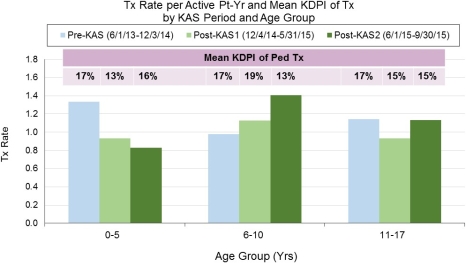Pediatric Access to Kidney Transplantation Under KAS.
1UNOS, Richmond, VA
2Univ. Hosp. Case Med Ctr, Cleveland, OH
3Texas Children's Hosp/Baylor College Medicine, Houston, TX.
Meeting: 2016 American Transplant Congress
Abstract number: 227
Keywords: Allocation, Ketoconazole, Kidney
Session Information
Session Name: Concurrent Session: Kidney: Pediatrics
Session Type: Concurrent Session
Date: Monday, June 13, 2016
Session Time: 2:30pm-4:00pm
 Presentation Time: 2:30pm-2:42pm
Presentation Time: 2:30pm-2:42pm
Location: Room 311
Background. Under the kidney allocation system (KAS) implemented on Dec 4, 2014, pediatric (ped) priority is now based on Kidney Donor Profile Index (KDPI) <35% instead of donors <35 yrs. This study examines whether ped access to kidney transplant (KI tx) changed under new KAS.
Data and Methods. OPTN database was used to compare the percent and mean KDPI of ped KI tx during 18 mos pre-KAS, first 6 mos post-KAS1, and additional 4 mos post-KAS2. Tx rate per active pt-yr was calculated for KI waitlist candidates in each KAS period. Relative risk (RR) of tx was approximated as the ratio of tx rates post- vs. pre-KAS. RR and 95% CL below/above 1 suggest significant decrease/increase in tx rate.
Results. Overall, ped tx represented 4.3% of all KI tx pre-KAS, 3.7% post-KAS1 and 4.2% post-KAS2. This figure illustrates changes in tx rates and mean KDPI by ped age group.

Compared to pre-KAS, tx rate was significantly lower for ages 0-5 during both post-KAS1 (RR=0.70; 95% CL: 0.49-0.99) and post-KAS2 (RR=0.62; 0.39-0.98). For ages 6-10, tx rate was higher post-KAS1 (RR=1.15; 0.82-1.62) and post-KAS2 (RR=1.44; 0.98-2.11), though the difference did not reach statistical significance possibly due to the small no. of patients. For ages 11-17, tx rate decreased significantly post-KAS1 (RR=0.82; 0.67-0.99) but returned to pre-KAS level in post-KAS2 (RR=0.99; 0.79-1.25). Mean KDPI of tx ranged from 13% to 19% across age groups and time periods.
Conclusions. The overall percent of ped tx returned to pre-KAS levels in post-KAS2. However, ages 0-5 subgroup had a sustained decline in tx rate post-KAS2, which could be an unintended consequence of Share KDPI 35% and reflect fewer appropriate size matches for this group. The possibility of even a small change in access for the ped population demands continued close monitoring by age group to assess whether change is a sustained effect of KAS or just due to random variability or bolus effects. Of note, compared to adults, ped tx rate post-KAS was still about 4 times higher. Low KDPI for peds was also maintained, which was an intended goal of the new KAS.
CITATION INFORMATION: Cherikh W, Stewart D, Kucheryavaya A, Aeder M, Brewer E. Pediatric Access to Kidney Transplantation Under KAS. Am J Transplant. 2016;16 (suppl 3).
To cite this abstract in AMA style:
Cherikh W, Stewart D, Kucheryavaya A, Aeder M, Brewer E. Pediatric Access to Kidney Transplantation Under KAS. [abstract]. Am J Transplant. 2016; 16 (suppl 3). https://atcmeetingabstracts.com/abstract/pediatric-access-to-kidney-transplantation-under-kas/. Accessed December 16, 2025.« Back to 2016 American Transplant Congress
